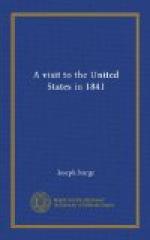In addition to the above models, the collection includes an almost innumerable variety of specimens of the fine arts and manufactures, comprising almost every article of use and luxury—furniture, modern and antique porcelain, models houses, pagodas, boats, junks, and bridges; pieces of silk, linen, cotton, grass-cloth, and other fabrics manufactured in China for home consumption; books and drawings, costume, idols, and appendages of worship; weapons, musical instruments, signs, mottoes, and entablatures, and numerous paintings, which last, it is justly observed, “will satisfy every candid mind that great injustice has been done to the Chinese artists, in the notion hitherto entertained respecting their want of skill. They paint insects, birds, fishes, fruits, flowers, with great correctness and beauty; and the brilliancy and variety of their colors cannot be surpassed. They group with considerable taste and effect, and their perspective—a department of the art in which they have been thought totally deficient—is often very good.”
Many of the paintings represent actual scenes and occurrences; and thus, like the models before mentioned, bring living China before the mind’s eye. The following is a good example.
“910. View of the interior of the Consoo House, with the court in session, for the final decision of the charge of piracy committed by the crew of a Chinese junk on a French captain and sailors, at a short distance from Macao.
“The French ship, Navigatre, put in to Cochin China in distress. Having disposed of her to the government, the captain, with his crew, took passage for Macao in a Chinese junk belonging to the province of Fokien. Part of their valuables consisted of about 100,000 dollars in specie. Four Chinese passengers bound for Macao, and one for Fokien, were also on board. This last apprised the Frenchmen in the best manner he could, that the crew of the junk had entered into a conspiracy to take their lives and seize their treasure. He urged that an armed watch should be kept. On reaching the Ladrone Islands, the poor Macao passengers left the junk. Here the Frenchmen believed themselves out of danger, and exhausted by sickness and long watching, yielded to a fatal repose. They were all massacred but one, a youth of about nineteen years of age, who escaped by leaping into the sea, after receiving several wounds. A fishing boat picked him up and landed him at Macao, where information was given to the officers of government, and the crew of the junk, with their ill-gotten gains, were seized, on their arrival at the port




